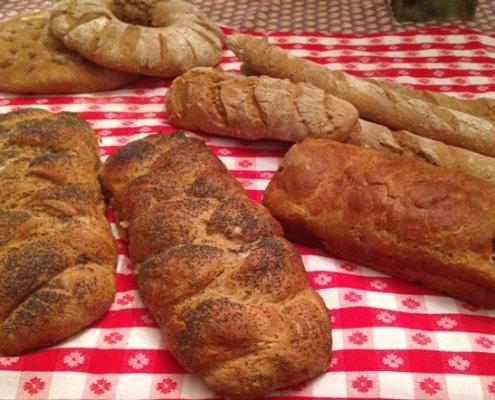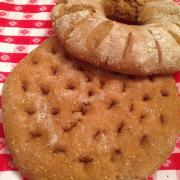Spelt Moroccan Bread Recipe. Khobz
Moroccan Bread is the only bread I ever make!
This, and my Challah. And always, only with spelt! Take a look at my Spelt Challah Recipe, I cannot tell you how many of my fans bake it every Shabbos. Lately I have added a fantastic No-Knead Challah Recipe too!
In Morocco, bread is not just the outside of a sandwich; it is sustenance itself. Every single morning, Moroccans make bread. They mix the dough, shape the loaves, let them rise, and wait for the young boy who will take them to the municipal oven, then back to the house just in time for lunch. No wonder the city streets are so fragrant and the local children so well coordinated, racing barefoot as they do, with huge trays balanced on their heads: No hands! You will not even find instructions for baking bread in most Moroccan bread recipes. They simply end with, “Let the loaves rise and send them to the oven.” Here, then, a recipe for my native bread, baked right at home. Exactly the way we ate it at home, and still do now:
Less Crumb, More Crust!
Impossibly fragrant from anise seeds, and studded with sesame seeds. Our crusty Moroccan bread makes the best toasts, sandwiches and Pan Bagnat
Spelt is my all time favorite flour:
Less Gluten! High Protein! High Fiber! Delicious Nutty Flavor
Read about my secrets of good whole grain bread, and you too will become a pro!
Because I use spelt flour so extensively, I buy it in big bags online, but you get in a smaller bags, online or in health foods store.
In Morocco, no one bothers to wrap the bread. What for? There won’t be a crumb left, and anyway, a fresh batch will be made the next day. Bread is stored for the day in flat wicker platters topped with dome covers called tbikas to protect them from dust and humidity. But I am not about to bake bread, not even Moroccan Bread, every day (and neither are you, I bet!), so I make a big recipe and freeze. So go ahead and double, even triple, this recipe.
You can shape Moroccan Bread in so many exciting ways!
Here are just a few, from a recent large batch

When I was growing up, we had a somewhat inconveniently plump rich cousin who had a masseuse come to her house twice a week to help reduce her unsightly bulges. Once her maid, intrigued, asked her, “ What is it that this lady does to you each time she comes?” To which my cousin answered self-consciously, “You know, if you massage a fat area often enough, you end up reducing it.” The maid looked horrified and replied vehemently, “Oh, no, madame! When you knead the dough, it grows, and grows, and grows!”
Ingredients
Makes 2 loaves, enough for 8 ample servings.
For a larger recipe, double all ingredients.
- 11⁄4 tablespoons active dry yeast
- 1⁄2 cup warm water
- 11⁄2 teaspoons sugar or honey
- 41⁄2 cups flour: all-purpose, whole wheat pastry, or spelt, just a little more if needed
- 1 cup warm water
- 2 tablespoons olive oil
- 1 teaspoon salt
- 1 tablespoon fennel or anise seeds
- 3 tablespoons sesame seeds
Instructions
Dissolve the yeast in 1⁄2 cup water.
Add the sugar and let the mixture “proof ” for a few minutes; the yeast mixture will bubble, “proof ” that it is active. Put the flour in a mixing bowl and add the yeast mixture, 1 cup warm water, oil, salt, fennel, and sesame seeds. Turn the mixture onto a worktable or board and knead it for about 15 minutes, turning the dough around to make sure you work on every corner, punching it down regularly to expel any air bubbles, until you have a firm but pliable dough (or place in the bowl of a dough maker and process for about 5 minutes). Divide the dough in half. Shape each half into a flat circular loaf, about 9 inches in diameter.
Arrange the loaves far enough apart on a cookie sheet to give them room to rise. Let rise, covered with a clean cloth, in a warm, draft-free place, about 2 hours. Prick the tops of the loaves all over with a fork. Bake in a preheated 375°F oven for about 35 minutes.
variation:
For Moroccan bread with a coarser texture, you can substitute 1 cup semolina flour for an equal amount of flour.




Hi Levana,
Finally a bread that reminds me of my grandmotger’s.
Quick question: after the dough rose, pricking with fork deflates it of course. Is it expected to rise again while baking? Mine has not, but the flavor was amazing.
Thanks,
Doron
Doron, it wont rise very much, but it still rises some.